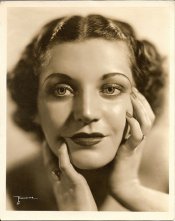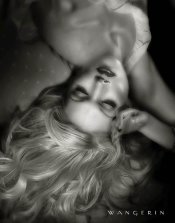dianna said:
I love everything about this look from the shallow DOF to the lighting. With such a shallow depth of field, I'm guessing that the photographer used modeling lights or some other constant light source and a wide aperture or large format camera. I would be grateful for any tips on how to achieve this look (BTW I don't own a set of studio strobes and don't have an interest in using them).
Hi Dianna,
First, here are my observations about this portrait:
-Classic Rembrandt lighting
-Main : medium-high, right, undiffused probably a wide-diameter tungsten fresnel
-Backlights : right and left kickers evidenced by reflection in hair and side of forehead and extreme edge of jowl
-Fill : low left, probably at head level as evidenced by catchlight and shadow on chin from finger .. Probably not very near lens as evidenced by canyon-shadows between hands, under chin
-Background light : flood maybe Mole Softlites
-Make-up : finished with a little coldcream as evidence by focused highlights on nose annd cheeks
-Lens : probably longer than normal, close-up, wide f/stop
-Film : probably ortho as evidenced by dark lips
As always for these type of portraits, there is quite heavy pencil retouching, and this portrait is a masterly example. I do not think a vignetter was used
and I do not notice any flagging or scrimming on the lighting, although with a portrait this well done, it's not always easy to tell.
To do the same today, just use the same materials and techniques (you have several good answers and suggestions above
particularly regarding retouching, which is
ABSOLUTELY necessary to achieve this look). Yes, you can "get away with" smaller format and other substitutions, but if you really want the same look, the solution is simple: do the same thing!
One difference: Today I use all Dedo lights, as the optical efficiency of the spotlights let me work in smaller spaces and at more comfortable levels of light. Plus, their barndoors (
essential for this kind of work) are the best I've ever seen.
Good luck and have fun!








